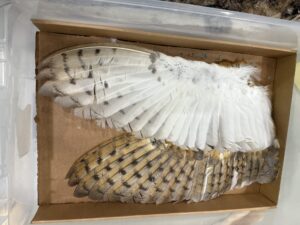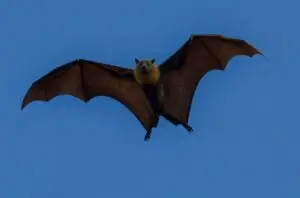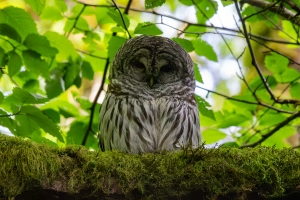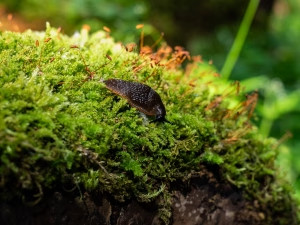Introduction/Abstract
There’s something special about being outside after dark. The world changes, sounds shift, and wildlife are roaming. I recently joined an adults only, ranger led night hike at my local nature center and I was able to experience something incredible. Between learning about local wildlife, like bats and owls, and having conversations in the near pitch black, it made me realize how powerful and immersive night time wildlife education can be.
Inside the Nature Center: Touching Nature’s Tools
Before heading out, our group gather inside the nature for a hands on introduction to the local wildlife. The ranger had set three tables of a variety of pelts, skulls, bones, and taxidermized animals. Each table represented a different activity period: animals that are active during the day (diurnal), at dawn and dusk (crepuscular), or at night (nocturnal). We saw a variety of interactable displays from barn owl wings to bat skeletons to full bear pelts. The collection offered a unique insight and interactive aspect of how animals survive and thrive at different times of day.
This short session was a fascinating way to kick off the evening and a great primer before exploring their world.

Bat Detectors and Echoes in the Night
As the sky darkened, we began our hike. One of the most exciting tools the ranger brought along was a bat detector, which converted the high frequency sounds of bat echolocation into audible sound waves. This allowed us to listen to bats flying and feeding on insects right above us!
Most of the bats we encountered were most likely little brown myotis (little brown bat, very creative) and yuma myotis. These two are very similar species that are hard to differentiate visually, especially when they silhouettes flying quickly around us. In fact, to confidently identify between the two, scientists need to do genetic testing! There was no way for the ranger to identify which one was which. There was also a chance we heard a big brown bat (another creatively named bat), though they tend to prefer more mature forests. The area around the nature center has a history of logging activity. Even though logging activity stopped about 100 years ago, the ranger told us that the forest still had about 200 years left before being considered “mature”.

An Unexpected Encounter: The Barred Owl
A little further along the trail, we had an unexpected wildlife moment- a barred owl was perched just off the path, almost in complete darkness. The ranger noted that it probably had a nest with fledglings nearby. The owl spread its wings, a warning that we were getting too close. We respectfully backed away as it swooped to a closer branch, perhaps trying to get a better look at us. We waited for quite some time before hearing fledglings call out and it flew away. Our ranger informed us that if the owl had started to hoot, that was a pretty good indicator that it was ready to defend its territory, even from a group of people.
It was a good reminder that there’s a fine line between observation and disturbance and how important it is to be as respectful in the habitats we enter.

The Slower Creatures: Slugs with a Story
As well as the bats, owls, and other wildlife mentioned during the hike, we found two slug species common to the area that I’ll mention briefly!
- Arion ater: An invasive slug species in the are that significantly impacts local agriculture. I can’t quite remember the exact percentage but this slug alone eats about 70% of all strawberries in the area!
- Leopard slug: A surprisingly fast slug that follows slime trails and preys on other slugs. It will slowly but surely catch up to other slugs in the night, devour the best parts, and leave them for people to find them in the morning.
Learning about these overlooked invertebrates reminded me that every level of the ecosystem holds so much drama and complexity.

Learning About Permits and Ethical Wildlife Collection
After the hike, we returned to the nature center where I asked the ranger about specimen collection collection. I was specifically interested in the legality around collecting things like feathers, bones, or the owl wings that were still on display. I learned that in order to legally collect animal remains, one has to apply for a scientific collection permit from the Department of Fish and Wildlife (at least for the state I’m in).
However, I unfortunately learned that these permits are only issued to scientist/researchers, educators/educational institutions, and museums, aquariums/zoos. In other words, they are not designed for the general public and I would not be able to be able to get one.
It did get me thinking about the future of WILD Education. If it continues to grow, getting a permit like this would open up a whole new category of education. I would love to explore different avenues of education that deepens public engagement with wildlife.
Why Night Hikes Matter for Wildlife Education
Programs like this align perfectly with WILD Education’s mission: making interactive wildlife learning accessible and exciting.
What stood out to me was that it was tailored specifically towards adults. Night hikes provide a safe, guided, environment where adults who might not usually engage with environmental education, can learn, connect, and rediscover the world of nature.
Nighttime programs like these are a powerful way to bridge the gap between formal science, and public appreciation for nature.
What’s Next: National Moth Week and Macro Photography
This weekend, I’ll be attending an event celebrating National Moth Week(July 19th-27th! One of the activities will be setting up a moth sheet and light to attract moths! I’m looking forward to this activity in particular since I’m hoping to be able to take some pictures of moths and practice some macro photography! If you’re wondering about how I got started with photography check, you can check this post out! Stay turned for images and stories from the event on Instagram!
Conclusion
This ranger led hike reminded me the value supporting government run programs that bring people and wildlife closer in a respectful way. Whether you’re watching an owl in its natural habitat or hearing bats for the first time, every night spent learning outdoors helps strengthen our connection to the environment.
If you’re looking for an adventure that combines learning and nature, I highly recommend looking for a night hike near you! Many parks and recreation departments host them for free! It’s one of the most immersive ways to experience the wild!


